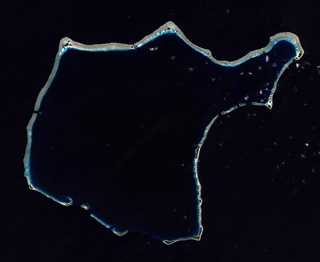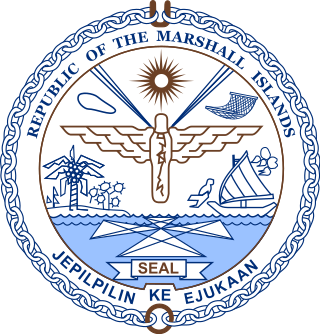Related Research Articles

The Marshall Islands, officially the Republic of the Marshall Islands, is an island country west of the International Date Line and north of the equator in the Micronesia region in the Northwestern Pacific Ocean. The territory consists of 29 coral atolls and five islands, divided across two island chains: Ratak in the east and Ralik in the west. 97.87% of its territory is water, the largest proportion of water to land of any sovereign state. The country shares maritime boundaries with Wake Island to the north, Kiribati to the southeast, Nauru to the south, and the Federated States of Micronesia to the west. The capital and largest city is Majuro, home to approximately half of the country's population.

Bikini Atoll, known as Eschscholtz Atoll between the 19th century and 1946, is a coral reef in the Marshall Islands consisting of 23 islands surrounding a 229.4-square-mile (594.1 km2) central lagoon. The atoll is at the northern end of the Ralik Chain, approximately 530 miles (850 km) northwest of the capital Majuro.

Enewetak Atoll is a large coral atoll of 40 islands in the Pacific Ocean and with its 296 people forms a legislative district of the Ralik Chain of the Marshall Islands. With a land area total less than 5.85 square kilometers (2.26 sq mi), it is no higher than 5 meters (16.4 ft) and surrounds a deep central lagoon, 80 kilometers (50 mi) in circumference. It is the second-westernmost atoll of the Ralik Chain and is 305 kilometers (190 mi) west from Bikini Atoll.

Ebeye is the populous island of Kwajalein Atoll in the Marshall Islands, and the second most populated in the Marshall Islands. It is a center for Marshallese culture in the Ralik Chain of the archipelago. Settled on 80 acres of land, it has a population of more than 15,000. Over 50% of the population is estimated to be under the age of 18.

Rongelap AtollRONG-gə-lap is an uninhabited coral atoll of 61 islands in the Pacific Ocean, and forms a legislative district of the Ralik Chain of the Marshall Islands. Its total land area is 8 square miles (21 km2). It encloses a lagoon with an area of 1,000 square miles (2,600 km2). It is historically notable for its close proximity to US hydrogen bomb tests in 1954, and was particularly devastated by fallout from the Castle Bravo test. The population asked the US to move them from Rongelap following the test due to high radiation levels, but with no success; so they asked global environmental group Greenpeace to help. The Rainbow Warrior made three trips moving the islanders, their possessions and over 100 tons of building materials to the island of Mejato in the Kwajalein Atoll, 180 kilometers away.

Kili Island or Kili Atoll is a small, 81 hectares island located in the Marshall Islands in the Pacific Ocean. As of 2021, 415 people lived on the island, many of whom were descended from islanders who originally lived on Bikini Atoll. They were relocated when they agreed to let the U.S. government temporarily use Bikini for nuclear testing in 1945, which they were told was of great importance to humankind, though it is sometimes considered a forced relocation. Kili Island became their home after two prior relocations failed. The island does not have a natural lagoon and cannot produce enough food to enable the islanders to be self-sufficient. It is part of the legislative district of the Ralik Chain of the Marshall Islands. The island is approximately 48 kilometers (30 mi) southwest of Jaluit. It is a good sized island for the Marshall Islands, but it is not an atoll with a lagoon.

Utirik Atoll or Utrik Atoll is a coral atoll of 10 islands in the Pacific Ocean, and forms a legislative district of the Ratak Chain of the Marshall Islands. Its total land area is only 2.4 square kilometers (0.94 sq mi), but it encloses a lagoon with an area of 57.7 square kilometers (22.29 sq mi). It is located approximately 47 kilometers (29 mi) east of Ujae Atoll. The population of Utirik Atoll was 264 at the 2021 census. It is one of the northernmost Marshall Islands with permanent habitation.

The Pacific Proving Grounds was the name given by the United States government to a number of sites in the Marshall Islands and a few other sites in the Pacific Ocean at which it conducted nuclear testing between 1946 and 1962. The U.S. tested a nuclear weapon on Bikini Atoll on June 30, 1946. This was followed by Baker on July 24, 1946.

Project 4.1 was the designation for a medical study and experimentation conducted by the United States of those residents of the Marshall Islands exposed to radioactive fallout from the March 1, 1954 Castle Bravo nuclear test at Bikini Atoll, which had an unexpectedly large yield. Government and mainstream historical sources point to the study being organized on March 6 or March 7, 1954, less than a week after the Bravo shot.

General elections were held in the Marshall Islands on 19 November 2007.

Although the military history of Oceania probably goes back thousands of years to the first human settlement in the region, little is known about war in Oceania until the arrival of Europeans. The introduction of firearms transformed conflict in the region; in some cases helping to unify regions and in others sparking large-scale tribal and civil wars. Force and the threat of force played a role in the annexation of most of Oceania to various European and American powers, but only in Australia and New Zealand did wars of conquest occur. Western Oceania was a major site of conflict in World War II as the Japanese Empire sought to expand southwards. Since 1945 the region has been mostly at peace, although Melanesia has suffered from Indonesian expansionism in some areas and civil wars and coups in others. The Australian Defence Force is by far the largest military force in Oceania.

Jeton Anjain was a Minister of Health and a senator of the Marshall Islands Parliament. He received the Goldman Environmental Prize in 1992, for his efforts to help people from the Rongelap Atoll, which was subject to nuclear contamination after the test of the Castle Bravo hydrogen bomb in 1954. In 1991, he and the Rongelap People were awarded the Right Livelihood Award for "their steadfast struggle against United States nuclear policy in support of their right to live on an unpolluted Rongelap island."
Japanese settlement in the Marshall Islands was spurred on by Japanese trade in the Pacific region. The first Japanese explorers arrived in the Marshall Islands in the late 19th century, although permanent settlements were not established until the 1920s. As compared to other Micronesian islands in the South Seas Mandate, there were fewer Japanese who settled in the islands. After the Japanese surrender in 1945, the Japanese populace were repatriated to Japan, although people of mixed Japanese–Marshallese heritage remained behind. They form a sizeable minority in the Marshall Islands' populace, and are well represented in the corporate, public and political sectors in the country.
Lijon Eknilang was a Marshallese activist and nuclear fallout survivor. Eknilang advocated on behalf of residents of Rongelap Atoll, who were victims of nuclear fallout stemming from the Castle Bravo hydrogen bomb test at Bikini Atoll in 1954.

Nuclear testing at Bikini Atoll consisted of the detonation of 23 nuclear weapons by the United States between 1946 and 1958 on Bikini Atoll in the Marshall Islands. Tests occurred at 7 test sites on the reef itself, on the sea, in the air, and underwater. The test weapons produced a combined yield of about 77 Mt of TNT in explosive power. After the inhabitants agreed to a temporary evacuation, to allow nuclear testing on Bikini, which they were told was of great importance to humankind, two nuclear weapons were detonated in 1946. About ten years later, additional tests with thermonuclear weapons in the late 1950s were also conducted. The first thermonuclear explosion was much more powerful than expected, and created a number of issues, but did demonstrate the dangers of such devices.
Darlene Keju, also known as Darlene Keju-Johnson, was a Marshallese activist. She was born on Ebeye Island in the Marshall Islands group in 1951. The Northern Islands where she grew up were downwind from Bikini and Enewetak atolls where the United States tested 67 nuclear weapons. She witnessed the evacuation of Regelap and Utirik Atolls after they were contaminated by radioactive fallout. Keju is credited for bringing to the attention of the world the suffering of the Marshall Islanders as a result of the nuclear testing and that many more people were affected than acknowledged by the U.S. government.
Giff Johnson is a Marshall Islands based editor and journalist. He is also the author of the self-published book Don't Ever Whisper which tells of his late wife Darlene Keju's fight to share the Marshall Islanders plight with the rest of the world wasn't being told of the events. In 2013, he was interviewed by ABC Radio presenter Geraldine Coutts in relation to the book.

Kenneth A. Kedi is a Marshallese politician. He was Speaker of the Legislature of the Marshall Islands between 2016 and 2024, having been re-elected in 2020. Kedi is a member of the Kien Eo Ad (KEA) party.

Abacca Anjain-Maddison is a former Senator in the Marshall Islands and is now the Deputy Chief Secretary of the country. She is known as a campaigner against nuclear weapons and nuclear testing and in support of greater efforts by the United States to clean up islands it used for nuclear testing.
References
- 1 2 3 Mayor wants to develop economy for Rongelap Archived 2011-07-24 at the Wayback Machine , July 7, 2005, Kyodo News Agency
- ↑ James heads Ports board, March 28, 2008, Marshall Islands Journal
- ↑ Nuclear Awareness Conference Archived 2010-06-23 at the Wayback Machine , April 23, 2008, University of Alaska
- ↑ Parks Air Force Base Pleasanton, California June 26 to August, 1956 Archived 2011-04-29 at the Wayback Machine , commemorative page by F. Sheff, retrieved October 17, 2009
- ↑ Interview with Almira Matayoshi Archived 2008-09-07 at the Wayback Machine , Nuclear Free News, retrieved October 19, 2009
- ↑ Diary 07-06-05, Honolulu Weekly
- ↑ James Matayoshi, Global Hibakusha, 1997
- ↑ Remarks of Rongelap Mayor James Matayoshi Bravo Day, March 1, 2004, Marshall Islands, Yokwe Online
- ↑ James Calls for Civilized Solution Archived 2011-06-16 at the Wayback Machine From the Marshall Islands Journal Friday, March 4, 2005
- ↑ Pacific Nuclear Victims Awarded One Billion Dollars, Giff Johnson, April 19, 2007
- ↑ U.S. REBUFFS RONGELAP LANDOWNERS, CUTS FUNDS Archived 2009-01-05 at the Wayback Machine , June 18, 2007, Giff Johnson, Pacific Islands Report
- ↑ Rongelap Resettlement Moves Ahead with Piggery Farm and Housing Projects, April 3, 2005, Yokwe Online
- ↑ McKenzie, Pete (February 15, 2023). "Bribes, booze and bombs: The brazen plan to create a Pacific tax haven" . The Washington Post . ISSN 0190-8286 . Retrieved 2023-03-05.